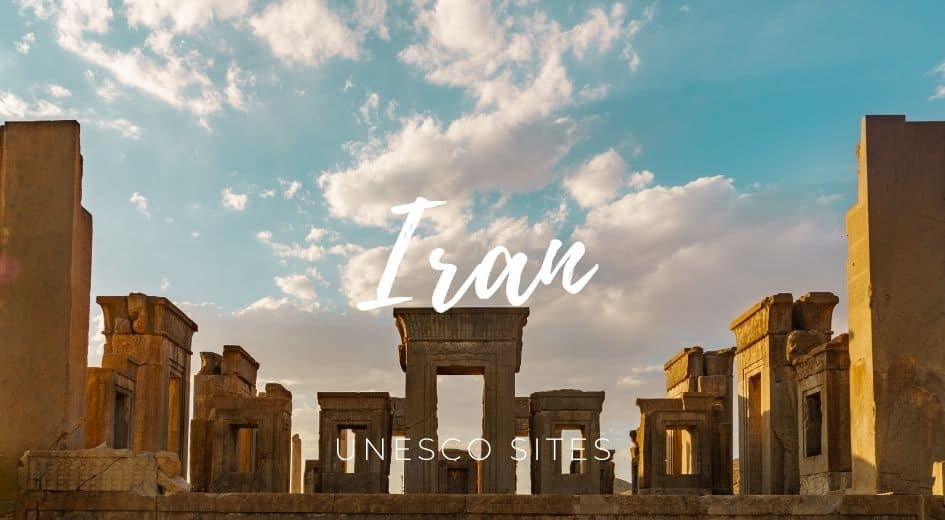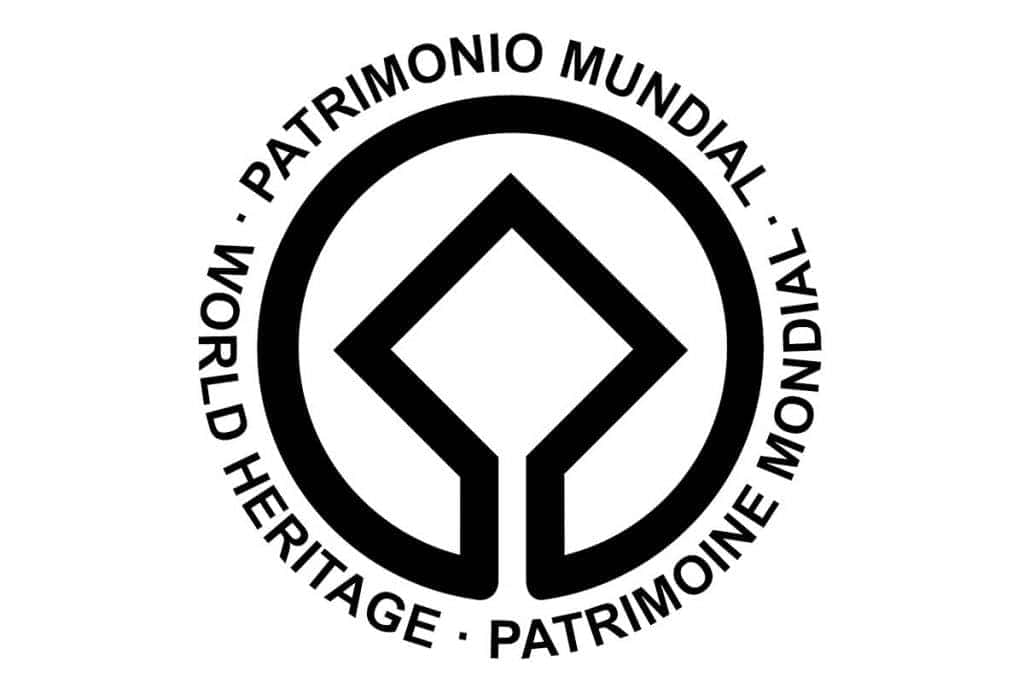Table of Contents


Iran UNESCO has registered 26 sites on the World Heritage list and 61 on the tentative list.
Some places are so interesting that it’s relevant to keep them for future generations. This is why UNESCO has built a list of crucial classified properties in which superb places stand out for their aesthetic, natural, artistic, or cultural significance.
More than a thousand places are registered as Unesco’s World Heritage worldwide. Due to my interest in visiting World Heritage sites, I compiled the UNESCO list in Iran and the corresponding map.
Iran UNESCO list
- Armenian Monastic Ensembles of Iran
- Bam and its Cultural Landscape
- Bisotun
- Cultural Landscape of Hawraman/Uramanat
- Cultural Landscape of Maymand
- Golestan Palace
- Gonbad-e Qābus
- Historic City of Yazd
- Masjed-e Jāmé of Isfahan
- Meidan Emam, Esfahan
- Pasargadae
- Persepolis
- Sassanid Archaeological Landscape of Fars Region
- Shahr-i Sokhta
- Sheikh Safi al-din Khānegāh and Shrine Ensemble in Ardabil
- Shushtar Historical Hydraulic System
- Soltaniyeh
- Susa
- Tabriz Historic Bazaar Complex
- Takht-e Soleyman
- Tchogha Zanbil
- The Persian Garden
- The Persian Qanat
- Trans-Iranian Railway
- Hyrcanian Forests
- Lut Desert
Iran UNESCO Map
Click on the blue pins to view more relevant information about each World Heritage site in Iran.
Description
- Armenian Monastic Ensembles of Iran: These are a group of Armenian Christian monasteries, churches, and chapels in northwestern Iran that date back to the 7th century AD.
- Bam and its Cultural Landscape: Bam is a city in southeastern Iran devastated by an earthquake in 2003. The cultural landscape around Bam includes a system of qanats (underground aqueducts) and the ancient fortress of Arg-e Bam.
- Bisotun: is a site in western Iran that contains a multilingual inscription carved into a cliff face by the Achaemenid king Darius I in the 5th century BC.
- Cultural Landscape of Hawraman/Uramanat: This cultural landscape is located in western Iran and is characterized by its mountainous terrain, traditional vernacular architecture, and agricultural practices.
- Cultural Landscape of Maymand: Maymand is a village in southeastern Iran famous for its troglodyte dwellings (houses carved into the rocks).
- Golestan Palace: is a complex of buildings located in Tehran that was the residence of the Qajar dynasty (1794-1925).
- Gonbad-e Qābus: Gonbad-e Qābus is a tower in northern Iran built in the 11th century AD and is an excellent example of early Islamic architecture.
- Historic City of Yazd: Yazd is a city in central Iran famous for its traditional mud brick architecture and Zoroastrian heritage.
- Masjed-e Jāmé of Isfahan: located in Isfahan was built in the 12th century AD and is considered one of the finest examples of Islamic architecture in Iran.
- Meidan Emam, Esfahan: is a public square in Isfahan that was built in the 17th century AD and is surrounded by some of Iran’s most famous Islamic buildings.
- Pasargadae: is an archaeological site in southern Iran that was the capital of the Achaemenid Empire under Cyrus the Great.
- Persepolis: is an archaeological site in southern Iran that was the ceremonial capital of the Achaemenid Empire.
- Sassanid Archaeological Landscape of Fars Region: This archaeological landscape is located in southern Iran and contains the ruins of several ancient cities that were part of the Sassanid Empire (224-651 AD).
- Shahr-i Sokhta: is an archaeological site in southeastern Iran that was an important center of trade and culture during the Bronze Age.
- Sheikh Safi al-din Khānegāh and Shrine Ensemble in Ardabil: This complex of buildings is located in northwestern Iran and is the burial place of Sheikh Safi al-Din Ardabili, a 14th-century mystic and founder of the Safavid dynasty.
- Shushtar Historical Hydraulic System: The Shushtar Historical Hydraulic System is a network of canals, tunnels, and bridges in southwestern Iran built in the 3rd century AD to irrigate the surrounding farmland.
- Soltaniyeh: is a city in northwestern Iran that contains the mausoleum of Oljaytu, a 14th-century Ilkhanid ruler.
- Susa: is an archaeological site in southwestern Iran, an important city in ancient Mesopotamia.
- Tabriz Historic Bazaar Complex is a large covered bazaar located in the city of Tabriz in northwest Iran. It consists of a network of interconnected buildings, courtyards, and alleys that date back to the 14th century. The bazaar has been an important center of trade and commerce for centuries and is a UNESCO World Heritage Site. It features various goods for sale, including textiles, carpets, jewelry, spices, and traditional handicrafts. The complex also includes several historic buildings and mosques, such as the Blue Mosque and the Jame Mosque of Tabriz.
- Takht-e Soleyman: is an archaeological site in northwestern Iran. It was a sacred site during the Sassanid Empire and is known for its impressive architecture and natural setting.
- Tchogha Zanbil: is an ancient Elamite city in southwestern Iran built in the 13th century BC and is known for its ziggurat (stepped pyramid).
- The Persian Garden: is a style of garden design that originated in Iran and is characterized by its use of water, symmetry, and various plants.
- The Persian Qanat: is an ancient system of underground water channels developed in Iran over 2,500 years ago and is still used today to irrigate farmland.
- Trans-Iranian Railway: This railway system spans Iran from the Persian Gulf to the Caspian Sea and was built in the early 20th century.
- Hyrcanian Forests: are a region of forest in northern Iran that is recognized as a UNESCO World Heritage Site and is known for its high biodiversity.
- Lut Desert: The Lut Desert is large in southeastern Iran and is known for its extreme temperatures and unique geological formations, including the Kaluts (sand formations).
UNESCO World Heritage Sites in Iran have protected places for their cultural and natural importance.
Sites on the Tentative List
- Jame’ (Congregational) Mosque of Esfahan
- Historic ensemble of Qasr-e Shirin
- Firuzabad Ensemble
- Shush
- Nasqsh-e Rostam and Naqsh-e Rajab
- Tape Sialk
- Taq-e Bostan
- Kuh-e Khuaja
- Persepolis and other relevant buildings
- The Historical-Cultural Axis of Fin, Sialk, Kashan
- Historical Ensemble of Qasr-e Shirin
- Historical Monument of Kangavar
- The Historical City of Maybod
- The Historical Port of Siraf
- Bazaar of Qaisariye in Laar
- The Historical Village of Abyaneh
- Bastam and Kharghan
- The Historical Texture of Damghan
- The Cultural-Natural Landscape of Ramsar
- Kaboud Mosque
- Tous Cultural Landscape
- The Historical City of Masouleh
- The Complex of Izadkhast
- Cultural Landscape of Alamout
- Zozan
- Khorramabad Valley
- Jiroft
- Ghaznavi- Seljukian Axis in Khorasan
- Qeshm Island
- Arasbaran Protected Area
- Sabalan
- Khabr National Park and Ruchun Wildlife Refuge
- Alisadr Cave
- Silk Route (Also Silk Road)
- The Natural-Historical Landscape of Izeh
- The Zandiyeh Ensemble of Fars Province
- Kerman Historical-Cultural Structure
- Hegmataneh
- The Collection of Historical Bridges
- Touran Biosphere Reserve
- Hamoun Lake
- Harra Protected Area
- Damavand
- Asbads (windmill) of Iran
- Natural-Historical Complex / Cave of Karaftoo
- Imam Reza Holy Complex
- Industrial Heritage of Textile in the Central Plateau of Iran
- Persian Caravanserai
- Salt Domes of Iran
- The Great Wall of Gorgan
- The Persian House in the Central Plateau of Iran
- University of Tehran
- Monastery of St. Amenaprkich (New Julfa Vank)
- Vali-e Asr Street
- Hyrcanian Forests
- Serial Nomination of Tehrans’ Modern Architectural Heritage
- Chega Sofla (Ritual Landscape of Chega Sofla)
- The architecture of the historical settlements across the northern coasts of the Persian Gulf (Siraf, Kong, Laft, Kish, and Mokran)
- Cultural Landscape of Kong Historic Port
- Long-lived trees of Iran
- Sheikh Ahmad-e Jām Khaneghah and Mausoleum Complex (Mazar-e Jām)


